I don’t recall how I managed to acquire this camera. It could be that someone gave it to me. I’ve mentioned before that I missed the entire autofocus fim era so it might be that reading a good review and finding a decently priced one prompted me to get it. Or it could be that it came with a lens that I could use on my Sony Alpha DSLR. I already have a number of Konica/Minolta/Sony lenses for the DSLR so maybe I thought that having a reasonably inexpensive, later model Minolta AF film camera would be nice (to go with my Nikon N90s, Canon EOS 650, and Canon EOS Elan IIe all of which I love to use).
It’s a Minolta Maxxum 5, the less expensive sibling of the Maxxum/Dynax 7 and 9 cameras, which still command significantly more money. My copy came with a Minolta 28-100 AF lens f3.5 (22)-f5.6 D lens, a strap, a Tiffen UV filter, and a lens hood. It’s also the data back version. (I don’t like data backs and so immediately turned it off) and has a BP-200 battery pack.
It’s very small and is quite light. I like the look and feel of it. While obviously designed to meet a low price point (i.e. lots of plastic) it feels quite solidly made. Because it’s an inexpensive camera, however, this doesn’t mean that it lacks features – quite the contrary. It has a top shutter speed of 1/4000; bracketing; continuous and 7-point autofocus; exposure compensation; automatic (from DX coding) or manual selection of ISO from 6-6400; and multiple exposure capability. It also has an interesting reset button, which returns all settings to default if you mess something up. Powerful, but perhaps a little bewildering are the 14 customizations, which allow you to set up the camera how you want it. They cover such areas as flash settings, leaving the film leader out, spot metering options, metering patterns, etc. Unfortunately you’ll probably need a “cheat sheet” to remember what they are as they are all referenced by number.
The top display shows all of the set options at a glance. Other controls for flash and exposure compensation, spot metering and selecting AF points are conveniently placed. The camera has a built in pop-up flash, which I doubt I’ll use (I’m terrible at flash photography and prefer to use available light). There are also buttons, which select (in conjunction with turning the command dial) scene modes (portrait, landscape, macro, action, night) and drive mode (single frame advance, continuous frame advance, self timer and remote control) options. To the bottom right on lens mount is a depth of field preview button, and on the left a manual/autofocus toggle button. On the right side of the body is a port for a wired remote. It’s the same as the port on my Sony Alpha 500 DSLR so I can use the wired remote with both cameras.
The camera also has “Eye Start” and begins to focus as soon as you lift it up. I don’t like this feature and immediately turned it off. Focus and exposure setting can be locked using a half press of the shutter button.
I found the mode dial initially a little confusing. For example to select aperture priority you have to turn the dial to PASM, then press and hold the central “func” button while turning the control dial on the front. This then cycles through the available options (seen on the top screen). When you reach ‘A’ you let go of the ‘func’ button and you’re all set. It’s not particularly difficult or time consuming – just different from what I was used to (i.e. selecting the programme mode directly from the dial itself). Other settings on the dial include bracketing options; audio signal; eye start, custom settings; ISO; AF options (A,C,S); red-eye reduction.
The viewfinder of the Maxxum 5 is bright and the display on the bottom shows just the essentials: focus pattern, focus confirmation, shutter speed, aperture and exposure setting.
It has a decent sized grip and was very pleasant to use. It would be easily possible to build a substantial system (body and older Minolta AF lenses) at very little cost. Definitely a very likable camera.
I’ll post some results later.

